use OpenGL;
#6 Equidomoid
This program draws an
Equidomoid.
An equidomoid is a non-polyhedral solid consisting of cylindrical wedges located symmetrically around an axis.
The equidomoids were studied (and named!) by Léopold Hugo, a nephew of Victor Hugo,
in a series of strange monographs.
You can read online its essays on
Hugodomoidal Geometry.
The equidomoid of order 4 is known as bicylinder or
Steinmetz solid.
Equidomoids of order 3, 5 and 32:
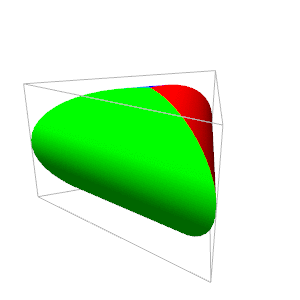
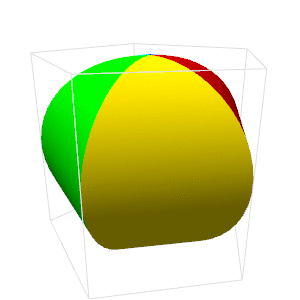
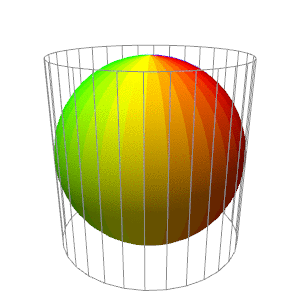
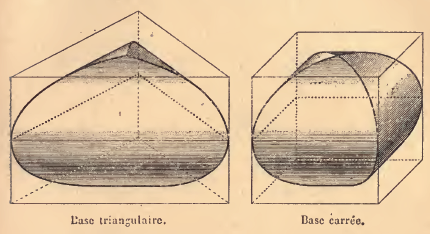
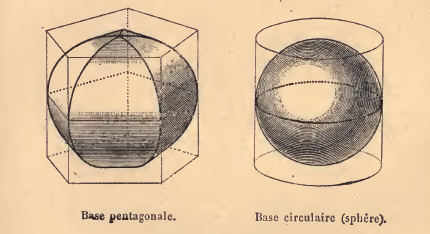
Figures from Émile Fourrey -
Curiosités géométriques (Paris 1910)
domoid.pl
#!/usr/local/bin/perl
#
# domoid.pl : draw an equidomoid
# (c) 2013 jl_morel@bribes.org - http://http://bribes.org/perl
use strict;
use warnings;
use Math::Trig;
use OpenGL qw/ :all /;
my $n = 6; # equidomoid order
my $scale = 2.8; # image scale
#------ Base vectors
my @i = ( 1, 0, 0 );
my @j = ( 0, 1, 0 );
my @k = ( 0, 0, 1 );
my @O = ( 0, 0, 0 );
#------ Draw a Cylindrical Wedge
sub DrawWedge {
my $n = shift;
# Setup the quadric object
my $qd = gluNewQuadric();
gluQuadricDrawStyle( $qd, GLU_FILL );
gluQuadricNormals( $qd, GLU_SMOOTH );
gluQuadricOrientation( $qd, GLU_OUTSIDE );
gluQuadricTexture( $qd, GL_FALSE );
# The cylinder is cut with two plans to get a wedge
glPushMatrix();
glClipPlane_p( GL_CLIP_PLANE0, sin( pi / $n ), 0, cos( pi / $n ), 0 );
glEnable(GL_CLIP_PLANE0);
glClipPlane_p( GL_CLIP_PLANE1, sin( pi / $n ), 0, -cos( pi / $n ), 0 );
glEnable(GL_CLIP_PLANE1);
glTranslatef( 0, 0, -2 );
gluCylinder( $qd, 1, 1, 4, 50, 1 );
glDisable(GL_CLIP_PLANE0);
glDisable(GL_CLIP_PLANE1);
glPopMatrix();
}
#------ Draw the equidomoid of order n
sub DrawEquidomoid {
my $n = shift;
for ( 0 .. $n - 1 ) {
glRotatef( rad2deg( 2 * pi / $n ), @j );
glColor3f( Rainbow( $_ / ( $n - 1 ) ) );
DrawWedge($n);
}
}
#------ Draw the bounding prism
sub DrawPrism {
my $n = shift;
my $r = 1 / cos( pi / $n );
my @alpha = map { ( 2 * $_ - 1 ) * pi / $n } ( 0 .. $n - 1 );
glColor3f( 0.8, 0.8, 0.8 ); # gray
glBegin(GL_LINE_LOOP); # bottom
glVertex3f( $r * cos($_), -1, $r * sin($_) ) foreach @alpha;
glEnd();
glBegin(GL_LINE_LOOP); # up
glVertex3f( $r * cos($_), 1, $r * sin($_) ) foreach @alpha;
glEnd();
glBegin(GL_LINES); # edges
foreach (@alpha) {
glVertex3f( $r * cos($_), 1, $r * sin($_) );
glVertex3f( $r * cos($_), -1, $r * sin($_) );
}
glEnd();
}
#------ Draw the scene
my $spin = 0;
sub display {
glClear( GL_COLOR_BUFFER_BIT | GL_DEPTH_BUFFER_BIT );
glLoadIdentity();
gluLookAt( 2.0, 4.0, 10.0, 0.0, 0.0, 0.0, 0.0, 1.0, 0.0 );
glPushMatrix();
glScalef( $scale, $scale, $scale );
glRotatef( $spin, @j );
DrawEquidomoid($n);
DrawPrism($n);
glPopMatrix();
glutSwapBuffers();
# debug code
# if ( ( my $e = glGetError() ) != GL_NO_ERROR ) {
# print "error : ", gluErrorString($e), "\n";
# }
}
#------ GLUT Callback called when the window is resized
sub reshape {
my ( $w, $h ) = @_;
glViewport( 0, 0, $w, $h );
glMatrixMode(GL_PROJECTION);
glLoadIdentity(); # define the projection
gluPerspective( 45, $h ? $w / $h : 0, 1, 20 );
glMatrixMode(GL_MODELVIEW);
glLoadIdentity();
}
#------ Routine for rotating the scene
my $WaitUntil = 0;
sub spinDisplay {
my $TimeNow = glutGet(GLUT_ELAPSED_TIME);
if ( $TimeNow >= $WaitUntil ) {
$spin += 1.0;
$spin = $spin - 360.0 if ( $spin > 360.0 );
glutPostRedisplay();
$WaitUntil = $TimeNow + 1000 / 25; # 25 frames/s
}
}
#------ GLUT callback for the mouse
sub mouse {
my ( $button, $state, $x, $y ) = @_;
if ( $button == GLUT_LEFT_BUTTON ) {
glutIdleFunc( \&spinDisplay ) if ( $state == GLUT_DOWN );
}
elsif ( $button == GLUT_RIGHT_BUTTON ) {
glutIdleFunc(undef) if ( $state == GLUT_DOWN );
}
}
#------ Initialization routine
my @light0_position = ( -2.0, 8.0, 5.0, 0.0 );
my @mat_amb_diff_color = ( 0.8, 0.8, 0.8, 1.0 );
my @light_diffuse = ( 2.0, 2.0, 2.0, 1.0 );
my @light_ambient = ( 0.2, 0.2, 0.2, 1 );
sub init {
glClearColor( 1, 1, 1, 1 ); # White background
glShadeModel(GL_SMOOTH); # Smooth shading
glEnable(GL_MULTISAMPLE); # Enable multisample antialiasing
glEnable(GL_DEPTH_TEST); # Enable hidden surface removal
glEnable(GL_LIGHTING);
glEnable(GL_LIGHT0);
# Light and material
glLightfv_p( GL_LIGHT0, GL_POSITION, @light0_position );
glLightfv_p( GL_LIGHT0, GL_DIFFUSE, @light_diffuse );
glLightfv_p( GL_LIGHT0, GL_AMBIENT, @light_ambient );
glMaterialfv_p( GL_FRONT, GL_AMBIENT_AND_DIFFUSE, @mat_amb_diff_color );
glEnable(GL_COLOR_MATERIAL); # Material track the current color
}
#------ Main
glutInit();
glutInitDisplayMode(
GLUT_DOUBLE # Double buffering
| GLUT_RGB # RGB color mode
| GLUT_DEPTH # Hidden surface removal
| GLUT_MULTISAMPLE # Multisample antialiasing
);
glutInitWindowSize( 300, 300 );
glutCreateWindow("Equidomoid");
init();
glutDisplayFunc( \&display );
glutReshapeFunc( \&reshape );
glutMouseFunc( \&mouse );
glutIdleFunc( \&spinDisplay );
glutMainLoop();
#------ Rainbow color map function
# Usage: ($red, $green, $blue) = Rainbow( $x );
# $x must be between 0 and 1.
# Returns the color of the rainbow (RGB list) associated with $x
# from blue for $x = 0 to red for $x = 1.
sub max { $_[0] < $_[1] ? $_[1] : $_[0] } # max auxiliary function
sub Rainbow {
my $dx = 0.8;
my $s = ( 6 - 2 * $dx ) * $_[0] + $dx;
return max( 0, ( 3 - abs( $s - 4 ) - abs( $s - 5 ) ) / 2 ), # Red
max( 0, ( 4 - abs( $s - 2 ) - abs( $s - 4 ) ) / 2 ), # Green
max( 0, ( 3 - abs( $s - 1 ) - abs( $s - 2 ) ) / 2 ); # Blue
}
The script as .txt for download:
domoid.pl.txt
Back to Top
BðP © 2013 J-L Morel - Contact : jl_morel@bribes.org
![[Validation HTML 4.0!]](vh401.gif)




